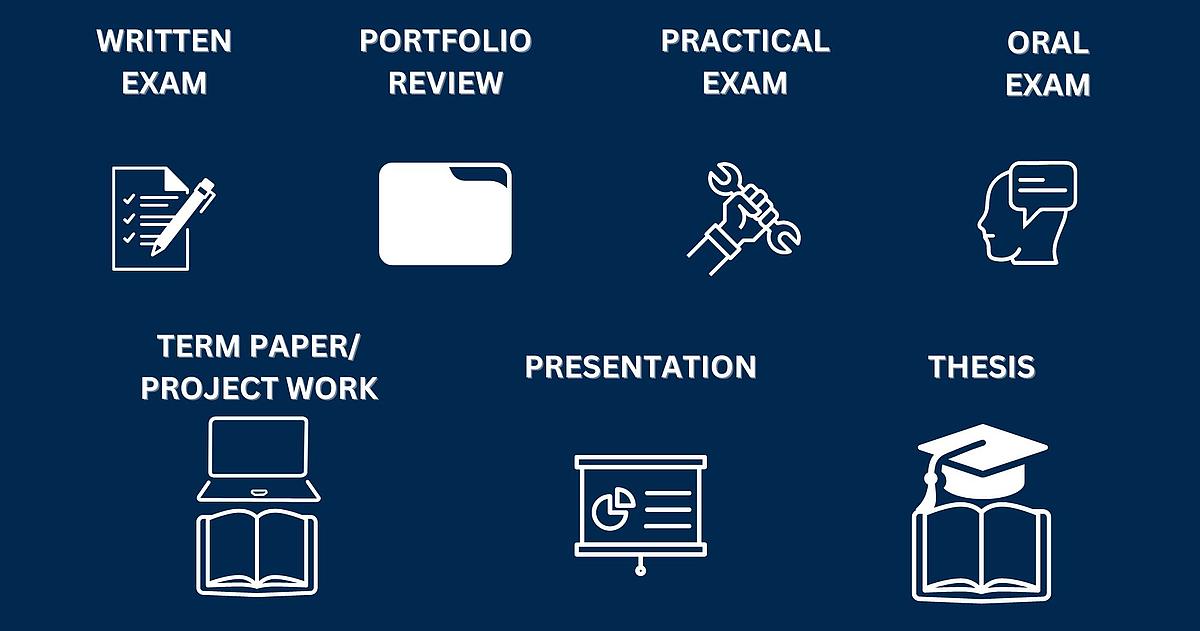This Website uses cookies to improve your visit on our website. More Info
Writing a Term Paper
When writing a term paper, many students feel overwhelmed. But with the right information and tips, this process can be made much easier. Discover how you can achieve a convincing result with targeted steps and less stress.
What is a Term Paper?
A term paper is a written piece of work that is written as part of a study program or an academic apprenticeship. It serves as a module or course completion and is intended to deal with a specific topic academically. Students should demonstrate that they are able to research information independently, evaluate it critically and produce a structured, argumentative and academically sound paper based on this information. Term papers usually include an introduction, a main section in which the topic is discussed in detail, and a concluding section. They include citations and references to the literature and sources used in order to support the argument and maintain academic honesty.
Why write a Term Paper?
Writing a term paper in an academic university fulfills several important functions in the educational process:
- Subject Expertise: Writing a term paper allows students to dive deep into a specific topic in their field, broadening and deepening their subject knowledge.
- Research Skills: By requiring students to independently research information, writing a term paper trains them to find, evaluate, and effectively utilize relevant sources.
- Critical Thinking: Analyzing different perspectives and engaging with existing research encourages critical thinking and the ability to draw independent conclusions.
- Argumentation Skills: Writing a term paper trains the ability to build a clear and logical argument as students learn to present their thoughts in a structured and persuasive manner.
- Academic Writing: Writing a term paper is designed to practice academic writing techniques, including proper citation and adherence to academic standards.
- Self-Management: Planning and completing a term paper requires a high degree of self-organization, time management and personal responsibility.
- Preparation for future Academic Work: Writing a term paper prepares students for more extensive academic projects, such as theses, by teaching basic methods of academic work.
Overall, writing a term paper contributes significantly to the academic and personal development of students and prepares them for the demands of their further studies and professional life.
What Types of Final Examinations are there for a Module at a University?
Universities have different types of final examinations for modules that require students to demonstrate different competencies and assess their knowledge and skills in different ways. The choice of examination type depends on the subject area, the learning objectives of the module and the pedagogical preferences of the teacher. Common forms of examination include

The 9 Steps of Writing a Term Paper
To make it easier for you to get started, we're breaking term paper writing down into nine simple steps that you can check off as you complete them. These are the nine main stages of writing a term paper:
Finding and narrowing down the Topic
Choose a topic that is both relevant to your interest and meets the requirements of the course. The topic should be neither too broad nor too specific to allow for a thorough analysis.
Writing an Exposé (optional)
Some lecturers require an exposé in which the topic, the research question, the state of research, the methodology and the preliminary outline are presented. The synopsis serves as a plan and orientation aid for the further work.
Literature Research
Search for relevant literature and sources that will give you a comprehensive understanding of the topic. Use libraries, specialist databases and the internet to find books, specialist articles and other relevant materials.
Read and take Notes
Read the literature you have found carefully and make notes on important information, arguments and perspectives that are relevant to your work.
Developing an Outline
Create a detailed outline of your work. This should include the introduction, the main body with various subsections and the conclusion. The outline helps you to structure your thoughts and develop a clear line of argument.
Writing Phase
Start writing a term paper by following the outline. It can be helpful to start with the sections you feel most confident with. Don't get caught up in the quest for perfection; the goal is to create a complete first draft.
Revision and Correction
Read through your draft carefully and revise it in terms of content, structure and argumentation. Pay attention to spelling, grammar and punctuation. It can be useful to give the work to someone else to proofread, as it is easy to become blind to your own mistakes.
Formatting and Citation
Make sure that your work complies with the formal and citation-related requirements. This includes the correct application of the prescribed citation style as well as compliance with formatting guidelines regarding font, line spacing and margins.
Conclusion
The last thing you should do is write the introduction, as you will already know what the term paper is about. Then you only have to finish the term paper by creating a list of sources, table of contents (if necessary) and a cover page.
Each of these steps is important in producing a quality term paper. The key to success lies in careful planning and organization, a thorough understanding of the topic, and academic honesty.

Formal Requirements
for writing a Term Paper

| Formatting | Font and font size: Times New Roman or Arial in 12 pt size is often used. |
|---|---|
| Line spacing: As a rule, 1.5 line spacing is required. | |
| Margins: Uniform margins of approx. 2.5 cm are often provided all around. | |
| Page numbering: Pages are usually numbered from the introduction onwards, although the cover page and table of contents are often excluded. | |
| Citation style and sources | The citation style (APA, MLA, Chicago, Harvard, etc.) is specified in order to cite sources correctly in the text and in the bibliography. |
| It is important to mark direct quotations, paraphrases and references consistently and according to the required citation style. | |
| Structure | A typical structure includes title/cover page, table of contents, introduction, main body, conclusion, bibliography/source list and, if applicable, appendices and affidavit. |
| The introduction introduces the topic, specifies the research question and explains the approach. | |
| The main body is logically structured, often organized by topic or argument. | |
| The conclusion summarizes the most important findings and reflects on the research question. | |
| Language | Clear, precise and objective scientific language is required. |
| Avoid colloquial language, subjective formulations and unnecessary filler words. | |
| Length | The required length is often specified in page numbers or word count and should be adhered to. |
| Title page | Usually contains the title of the thesis, the student's name, matriculation number, details of the seminar or course, the lecturer and the submission date. |
| Plagiarism check | Many universities require a sworn declaration that the thesis was written independently and does not contain any plagiarism. |
The formal requirements for writing a term paper can vary depending on the university, department or even course. It is therefore important to follow the specific guidelines provided by the respective institution or lecturer. Paying close attention to the formal guidelines is crucial, as they not only contribute to the clarity and readability of the paper, but are also part of the assessment criteria. You should therefore familiarize yourself thoroughly with the specific requirements before starting your thesis.
Writing a Term Paper: Structure explained in more Detail
The structure of a typical term paper usually follows a standardized scheme consisting of an introduction, main body and conclusion. Each of these parts fulfills a specific function in the overall context of the paper and helps to deal with the topic in a structured and comprehensible way. Formalities such as a cover page or a list of sources are also important. Clear structuring and attention to the specific functions of the individual parts are crucial for the quality of a term paper. They help to ensure that the argumentation is comprehensible, convincing and scientifically sound. The individual parts of a term paper are briefly explained below and provided with an example.

Title/Cover Page
The cover page of a term paper is the first thing a supervisor or examiner sees and therefore gives a first impression of the work. It should be clear and informative. The following elements typically belong on a cover page when writing a term paper:
- Title of the term paper: The title should precisely reflect the topic of the paper, and may be supplemented by a subtitle providing further details if necessary.
- Name of the student: Full name of the person who wrote the term paper.
- Matriculation number: The student's matriculation number for administrative purposes.
- Degree program: Indication of the degree program or faculty in which the student is enrolled.
- Name of the college or university: The full name of the educational institution.
- Name of the lecturer or supervisor: The person responsible for supervising the term paper or leading the course.
- Name of the associated course/seminar: Full name of the course, seminar or lecture to which the term paper is assigned.
- Submission date: The date on which the term paper is submitted.
- Semester: The semester in which the term paper was written is optional.
The cover page should not contain any decorations or unnecessary information in order to maintain professionalism. However, the exact specifications for the cover page may vary depending on the university or department, so it is advisable to find out about the specific requirements in advance. It should ideally be clear and well-organized, but apart from that, the design is usually free.
Introduction
The introduction has the task of arousing the reader's interest, introducing the topic, formulating the central question or thesis and providing an overview of the structure of the paper.
Example: Imagine you are writing a term paper on the impact of social media on society. In the introduction, you could point out the increasing importance of social media in today's society, introduce the central question, e.g. how social media has changed communication behavior, and briefly outline the structure of your argument.

Main Part
The main part is the core of the term paper, in which the topic is dealt with in detail. It consists of several sections or chapters that build on each other logically and highlight different aspects of the question. Each section should have a clear heading and deal with an independent argument or a sub-aspect of the topic. It is important to argue on the basis of the researched literature and sources and to include your own analyses.
Example: In the case of the term paper on social media, the main body could include the following sections: the historical development of social media, its role in modern communication, positive and negative effects on society (e.g. improved networking vs. privacy issues), and a discussion of specific case studies or studies.
Conclusion
The final section summarizes the points discussed in the main section and draws a conclusion. The aim is to answer the central question. In addition, the conclusion offers the opportunity to place the results of the work in a wider context, to reflect on the implications of the findings and to point out possible follow-up questions or the need for further research.
Example: In the conclusion of the term paper on social media, you could summarize how social media has changed communication behavior, highlight the most important positive and negative effects and finally emphasize the importance of a critical examination of social media in today's society. You could also make suggestions for further research or policy measures.
Bibliography / List of Sources
In addition to these parts, a term paper usually also includes a bibliography in which all sources used are listed in full and according to a standardized scheme. This serves to make the statements made in the paper comprehensible and verifiable. For online sources, you should also add the date on which the information was retrieved, as the content of websites can change constantly.
Appendix (optional)
If relevant, additional materials, such as extensive tables, questionnaires or illustrations, can be added to the appendix of the paper.
Writing a Term Paper: Set up a Schedule?
Creating a schedule is essential to writing your term paper efficiently and without unnecessary stress. Here are steps on how to create such a schedule for writing a term paper:
| Note deadlines | Write down the submission deadline and other relevant dates (such as library closures or public holidays). |
|---|---|
| Divide work into tasks | Break the process down into smaller tasks (finding a topic, researching, outlining, writing the individual sections, revising, proofreading). |
| Estimate time requirements | Estimate how much time you will need for each task. Be realistic and plan additional buffer time. |
| Prioritize | Determine which tasks are most important and which can possibly be done at the same time. |
| Set a start date | Set a start date for your work that gives you enough time until the deadline. Take into account other commitments such as lectures or part-time jobs. |
| Schedule fixed working hours | Schedule fixed times to work on your term paper. Take your personal peak periods of productivity into account. |
| Set milestones | Define milestones (e.g. completion of research, completion of the rough draft) and assign fixed deadlines to them. |
| Schedule feedback | Schedule time for feedback from supervisors or fellow students. This can give you valuable information for the revision. |
| Revision and proofreading | Allow sufficient time for revision and proofreading. These steps are often underestimated. |
| Maintain flexibility | Your schedule should be flexible. Unforeseen events may occur and you may need to make adjustments. |
| Monitor and adjust | Monitor your progress regularly and adjust the schedule as needed. |
Example of a Timetable for writing a Term Paper
Let's say you have 6 weeks to write your term paper. Your schedule could look like this:
- Week 1: Topic identification and initial research
- Week 2: Detailed research and creation of the outline
- Week 3-4: Writing the first draft (e.g. one main section each week)
- Week 5: First revision and obtaining feedback
- Week 6: Final revision, proofreading and formatting
By sticking to such a schedule, you can ensure that you work in a structured way, reduce stress and complete your term paper on time and in good quality.
12 Tips for writing a Term Paper
With our tips, you can systematize the process of writing a term paper and make it more effective in order to achieve a high-quality result. When writing a term paper, the following tips can help make the process easier and improve the end result:

- Start early: You should start writing a term paper early in order to have enough time for research, formulation and revision. This will help you avoid stress and give you room for unforeseen challenges.
- Understand the topic thoroughly: Choose a topic that interests you and for which sufficient sources are available. Understand the requirements and the goal of your term paper in order to stay focused.
- Create a clear outline: Before you start writing a term paper, create a detailed outline. This will help you to structure your thoughts and have a clear direction for your work.
- Conduct effective research: Use academic databases, books and trusted internet sources to gather information. Record your sources carefully to make it easier to cite later.
- Think and analyze critically: Question the information you find and reflect critically on different perspectives. Your term paper should not only summarize knowledge, but also contain your own analyses and conclusions.
- Write clearly and in a structured way: Use clear language and stick to the given structure (introduction, main body, conclusion). Each section should have a clear purpose and contribute to the overall argument.
- Use quotations and references correctly: Make sure you cite and format your references correctly to avoid plagiarism and maintain the academic integrity of your work.
- Take regular breaks: Long sessions of writing a term paper at a stretch can lead to fatigue. Short, regular breaks help to keep your mind fresh and increase productivity.
- Get feedback: Have your term paper read by others, be it fellow students, tutors or teachers. Constructive feedback can help you to identify and improve weak points.
- Revise several times: The first draft is rarely perfect. Revise your term paper several times to refine content, strengthen arguments and correct errors.
- Pay attention to language and grammar: Before final submission, you should thoroughly check your term paper for spelling, grammar and punctuation errors.
- Observe guidelines and format specifications: Make sure your term paper follows the specific guidelines of your institute or department, including formatting, page numbers and submission formats.

writing a Term Paper
Tips for motivation

| Arouse interest in the topic | Choose a topic that really interests you. If you are personally involved in the topic, this will increase your motivation to delve deeper into it and approach writing a term paper with enthusiasm. |
|---|---|
| Set clear goals | Define specific, measurable, achievable, relevant and time-bound (SMART) goals for your work. Small, achievable goals can help make the overarching project less overwhelming. |
| Create a work plan | Break the work down into smaller, manageable tasks and create a timeline. Check your progress regularly and adjust the plan as needed. |
| Establish regular work routines | Set fixed times for writing a term paper and stick to them. A routine can help you avoid procrastination and make writing a term paper a fixed part of your everyday life. |
| Set rewards | Reward yourself for achieving intermediate goals. This can be as simple as a short break, a favorite snack or an activity you enjoy. |
| Create a positive environment | Find a calm, inspiring workspace that is free from distractions. A pleasant work environment can increase productivity and motivation for writing a term paper. |
| Seek social support | Share your goals and progress with friends, family members or fellow students. They can motivate, support and hold you accountable. |
| Practice self-care | Make sure you get enough sleep, eat healthy and exercise regularly. Good physical and mental health is essential to staying motivated enough to write a term paper. |
| Visualize success | Imagine what it will be like to hand in the finished term paper and receive good grades. This positive visualization can be a powerful motivator. |
| Dealing with setbacks | Accept that there will be days when you are less productive. See these as part of the process and not as failures. Use setbacks as learning opportunities. |
| Connect interests | Try to find connections between your term paper topic and your personal interests or future career goals. This can increase the relevance and thus your motivation to follow through with writing a term paper. |
Finding and maintaining motivation when writing a term paper can be challenging, but there are effective strategies that can help. By combining these strategies, you can not only find the motivation to start writing your term paper, but also develop the perseverance to stick with your term paper writing phase and finish it successfully.
Writing a Term Paper: Plagiarism Check
A plagiarism check is an important step in the academic writing process. Conducting a plagiarism check before submitting an academic paper is an essential step in ensuring academic credibility and meeting legal and ethical standards. By utilizing available resources and careful review, the originality and integrity of the work, while writing a term paper, can be ensured. Here are reasons why a plagiarism check is necessary when writing a term paper and how to do it:
Why is a Plagiarism Check necessary?
- Maintain academic integrity: It helps to follow the academic principles of honesty and proper citation.
- Avoid plagiarism: Even unintentional plagiarism can have serious consequences, including poor grades, loss of academic reputation or even disciplinary action.
- Self-checking: It provides an opportunity to check your own work and ensure that all information used has been appropriately cited and paraphrased.
- Quality improvement: The check can identify areas where the originality and merit of the work can be strengthened.

How do you carry out a Plagiarism Check?
- Use online plagiarism checks: There are many plagiarism checking tools and software solutions available online. Some are free, while others charge a fee for more comprehensive features. Popular examples include Turnitin, Plagscan, Copyscape and Grammarly.
- In-house resources: Many colleges and universities offer access to plagiarism checking tools through their libraries or IT departments. These tools are often designed specifically for academic purposes.
- Manual checking: In addition to automated tools, it is useful to check citations and paraphrasing manually to ensure that they are correct and appropriate. This includes checking the references and comparing your own work with the original sources.
- Follow guidelines: Check the specific citation guidelines of your department or university, as these requirements may vary from discipline to discipline.
- Get feedback: Sometimes it can be helpful to ask a supervisor, teacher or an experienced fellow student to check parts of your work for potential plagiarism problems.
Last Tip: Don't let others write your Term Paper!
Not even ChatGPT & other AIs
Using ChatGPT, another AI or a third party to write a term paper is not a good idea for several reasons:
- Academic integrity: Colleges and universities place a high value on academic honesty. Submitting work that is not your own violates the principles of academic integrity and can have serious consequences, including disciplinary action or even expulsion from the institution.
- Learning Opportunities: Writing a term paper is an important learning experience aimed at developing your research, writing and critical thinking skills. By bypassing the process, you deprive yourself of the opportunity to practice and improve these important skills that are essential to your academic and professional future.
- Quality and relevance issues: Even the most advanced AIs like ChatGPT can't always deliver the depth and nuance required in a quality academic paper. They also can't guarantee that the content produced will be fully relevant or meet the specific requirements of your course.
- Lack of personal insight and perspective: one of the main strengths of a good term paper is the uniqueness of your perspective and analysis. A paper written by an AI or another person will lack this personal insight and originality, which is often a key aspect of assessment.
- Developing research skills: Researching and evaluating sources is a central part of writing a term paper. If you skip this process, you will miss out on the opportunity to develop important research skills that can be useful in your academic and professional life.
- Ethics and responsibility: Ethics in academic work and professional life is fundamental. The practice of having someone else write for your term paper undermines ethical standards and does not prepare you to act responsibly and with integrity in your future career.
- Getting caught: Ultimately, this is an attempt to cheat, which usually fails and can lead to failing. The risk is not worth it, especially because the quality rarely justifies the act.
To summarize, writing a term paper independently is essential to developing the full range of skills needed to succeed in your academic and professional life. Not only does it enhance your learning and development, but it also ensures that you adhere to the ethical and academic standards that are valued in education and beyond.
Frequently asked Questions about writing a Term Paper
The time it takes to write a term paper can vary greatly and depends on several factors, such as the length of the paper, the complexity of the topic, individual writing skills, availability of resources and efficiency in research and organization. On average, however, it can be assumed that a term paper of 10 to 20 pages will take about two to four weeks if you work on it for several hours a day. For more extensive work or more intensive research, this period can be significantly longer. It is important to allow enough time for planning, research, writing and revision.
The optimal daily writing time for a term paper can vary from person to person, but a good guideline is 3 to 5 hours per day. This amount of time allows for concentrated work without leading to fatigue or burnout. It is important to schedule regular breaks to maintain productivity and concentration. Longer writing sessions may be necessary in some phases, but should remain the exception so as not to impair the quality of the work.
Various programs are suitable for writing a term paper, the choice depends on personal preferences and requirements. Microsoft Word is a popular choice due to its widespread availability, extensive word processing and formatting features, and compatibility with most university standards. Google Docs offers a good alternative for those who value real-time collaboration and accessibility from multiple devices. LaTeX is particularly suitable for papers containing many mathematical formulas or complex tables and graphs, as it allows precise control over layout. Scrivener is another option that can be especially helpful for large projects, as it provides tools to organize and structure the writing process.
The difficulty of writing a term paper depends on various factors, such as the individual's level of knowledge on the topic, writing skills, the complexity of the assignment and the requirements of the subject area. Some students find writing a term paper challenging, mainly because of the need to formulate a clear thesis, conduct extensive research and present the information in a structured and coherent manner. Others find it less difficult, especially if they are familiar with the topic and have good organizational and writing skills. Proper planning, early preparation and use of resources such as writing centers or guides can significantly reduce the difficulty.
You can use ChatGPT to help you write a term paper. ChatGPT can help with brainstorming, creating outlines, formulating sections of text and explaining complex concepts. However, it is important to note that ChatGPT only provides support and the final paper should reflect your own analysis, critique and synthesis of the researched information. In addition, one must ensure that all academic standards and citation rules are followed. The use of ChatGPT is not a substitute for thorough research and critical analysis of the topic.
Interested in a study program? Request our information material now!
More exciting Degree Programs in Munich












